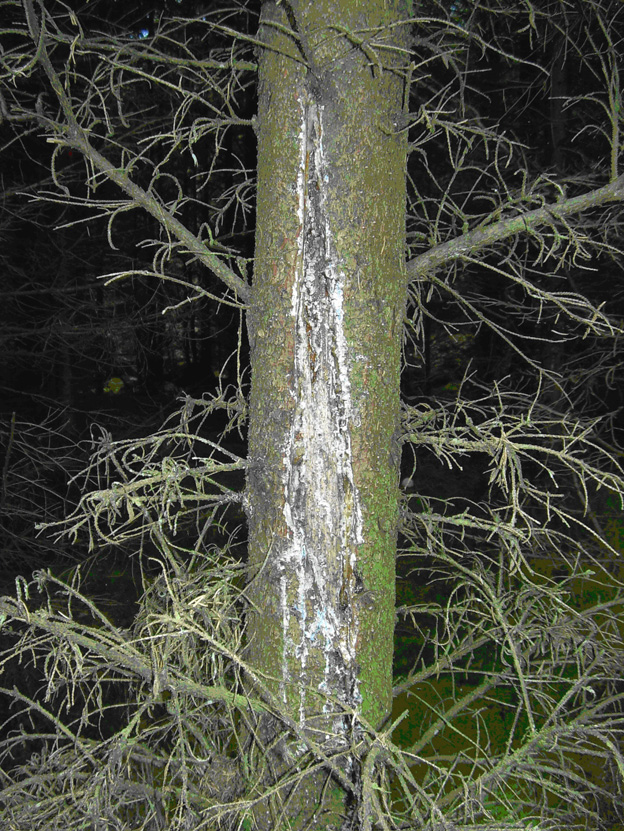PESTS AND DISEASES OF FORESTRY IN NEW ZEALAND
Nectria ecology collaboration with Scandanavia
Scion is the leading provider of forest-related knowledge in New Zealand
Formerly known as the Forest Research Institute, Scion has been a leader in research relating to forest health for over 50 years. The Rotorua-based Crown Research Institute continues to provide science that will protect all forests from damage caused by insect pests, pathogens and weeds. The information presented below arises from these research activities.
From Forest Health News 188, October 2008.
Neonectria fuckeliana is the fungus associated with Nectria flute canker disease in Pinus radiata in the South Island of New Zealand. The fungus is an introduced species and was first formally recorded in New Zealand in 1996, although it is likely to have been present for some years prior to this time. It originates from Northern Europe and North America where it is found as a saprophyte or wound invader of species of spruce and fir Interestingly, it causes little or no natural disease in spruce or fir and is not considered to be an important pathogen in the Northern Hemisphere. It has not been recorded on native pines in the Northern Hemisphere.

In August and September this year, Anna Hopkins from Scion spent five weeks in Sweden and Denmark working on a collaborative research project on the fungus Neonectria fuckeliana with scientists from two prominent Scandinavian universities. The principle aims of this research are to exchange isolates and genetic material of N. fuckeliana as well comparing the behaviour of the fungus in Scandinavia and New Zealand.
In Sweden Anna was hosted by Dr Rimvys Vasiatis from the Swedish University of Agricultural Sciences in Uppsala. Rimvys is a forest pathologist and molecular biologist who has published a number of papers on the ecology and genetics of N. fuckeliana in Sweden and Lithuania. Anna was able to access Rimvys' vast collection of isolates of N. fuckeliana from throughout Scandinavia and the Baltic States and use these for a number of ecological and genetic studies. Along with Rimvys and colleague Jan Stenlid, Anna was also given the opportunity to see N. fuckeliana in its natural habitat by visiting Norway spruce plantations around Uppsala. One of the most obvious differences with New Zealand radiata plantations was that Norway spruce is not pruned in Swedish plantations. The stocking rates are fairly high however, resulting in much smaller branch sizes and trees that tend to self-prune.
In Denmark, Anna was hosted by Dr Iben Thomsen from Forest and Landscape Denmark, now a part of the University of Copenhagen. Together Iben and Anna visited a large number of Norway spruce plantations throughout Denmark and were lucky enough to observe fruitbodies of N. fuckeliana on numerous occasions and to make several collections. The fungus was found almost exclusively on stem wounds of Norway spruce caused by deer bark stripping during winter. Despite frequent large wounds and excessive resin production, trees were rarely observed with canker symptoms, even when N. fuckeliana was present in the stem.
Another useful aspect of the exchange was the opportunity to meet many staff and students at the Swedish University of Agricultural Sciences and the University of Copenhagen and to exchange ideas about forest pathology research in Scandinavia and New Zealand. Anna presented her work in seminars in both Sweden and Denmark and was also able to attend seminars and observe research undertaken by local researchers.
Now that Anna is back in New Zealand, the collaboration with Rimvys and Iben will continue with further studies comparing the ecology and genetics of N. fuckeliana in Scandinavia and New Zealand. Early results indicate that the behaviour of N. fuckeliana is similar in Scandinavia and New Zealand. As a result, it appears likely that the high levels of disease caused by N. fuckeliana in New Zealand are related to the different environmental conditions, silvicultural practices and host characteristics compared with the Northern Hemisphere, rather than a change in the behaviour of the fungus itself. Further experiments are currently under way to test this theory - watch this space!
Anna's travel was funded by the Bilateral Research Activities Programme which is a part of the International Science and Technology Linkages Fund of the Ministry of Research, Science and Technology.
Anna Hopkins
This information is intended for general interest only. It is not intended to be a substitute for specific specialist advice on any matter and should not be relied on for that purpose. Scion will not be liable for any direct, indirect, incidental, special, consequential or exemplary damages, loss of profits, or any other intangible losses that result from using the information provided on this site.
(Scion is the trading name of the New Zealand Forest Research Institute Limited.)

 Farm Forestry New Zealand
Farm Forestry New Zealand

